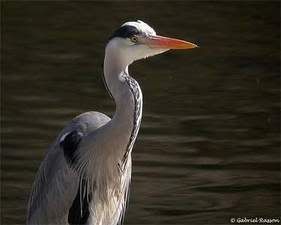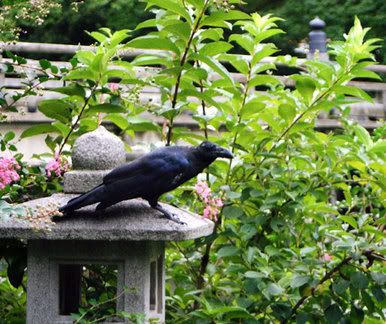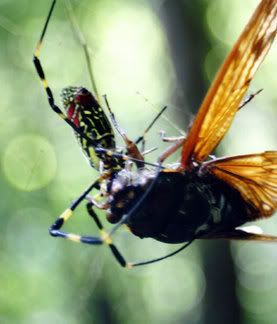
Gray Heron (Ardea cinerea):
These familiar looking herons were plentiful in the numerous rivers and streams of Japan. It made little difference to them if the stream bed had been coated in concrete - a common practice in Japan - or if apartments lined the banks; there they stood, looking remarkably like the Great Blue Heron (Ardea herodias) so well known in the Americas. Interestingly, it seems Ardea cinerea has been even more successful than A. herodias, having populated three continents: Europe, Asia, and Africa. (By the way, why is Europe considered a continent again?)
Rufous Turtle-Dove (Streptopelia orientalis):
This bird superficially resembles the mourning dove (Zenaida macroura), a handsome species I hunted in the harvested fields of Virginia every fall of my youth. As the name suggests, the rufous turtle-dove has browns and reds in the plumage. It is also more heavy-bodied than many other dove species, though still smaller than the rock dove (Columba livia), better known to most urban folks as the pigeon.

Carrion Crow (Corvus corone orientalis):
As I have mentioned before, I have a soft spot for the corvid family. Jays, crows, ravens...oh, my! The Carrion Crow stands out because of the terrific name and its alarming size. My friend Ben contends that these large crows are the inspiration for the giant corvids populating so many video games (“Resident Evil,” for example). I believe it. They seem to be half again as large as your average American crow (Corvus brachyrhynchos) or Fish crow (Corvus ossifragus) and their scratchy squawk is a staple of Buddhist cemeteries and Shinto shrines. The irridescent quality of their plumage is readily apparent, particularly around the neck.
Unfortunately, I was unable to get very close to any of the carrion crows; they are a skiddish bunch. To get the picture above, I had to approach the bird without making eye contact, taking care to keep my gaze directed at the ground until I was within six feet. As soon as I raised the camera, the bird began shifting about, taking flight just moments after I snapped the slightly blurry photograph. Situations like this one had me cursing my decision not to bring my wildlife lens, the 280mm big boy or, as I like to call it, the Sweaty Butcher.
Insects (and spiders) Galore:
If I were a more knowledgeable amateur entomologist, or if I had a really good insect field guide handy while in country, I could have filled pages with the names of insect species I encountered. Katydids in the shower, cicadas whining in the trees, cranefly-like creatures hovering alongside trails, millipedes on fallen tree trunks, many species of ants rushing about their business, mosquitoes in the bedroom... Japan is an insect haven. The rainforests of Central and South America are teeming with insect life, almost certainly without compare, but I was nevertheless impressed by the sheer abundance found on Honshu. Below I give more detail about one spider species which I was able to identify. (Check out “Encounter With The Giant Asian Hornet (Vespa mandarinia)” for information about another frequently encountered species.)

Giant Wood Spider (Nephila maculata):
A member of the orb web spider family, the giant wood spider provided me with repeated frights. I admire spiders a great deal as predators and find them to be generally fascinating creatures, but I still act irrationally when I believe a large spider might be on me. Several times I yelped and frantically brushed webbing from my face and hair, convinced I was about to be bitten by one of these hulking arachnids. Of course, I never was. In fact, I never even had a spider on me, though I did destroy quite a few webs with my hystrionics. In any event, my antics provided Ben with much mirth, so some good came of it.
The female wood spiders are quite large, and rather striking, especially when compared to the smaller, dull-colored males. As with many orb weaver spiders, the male Nephila maculate searches out a female and takes up residence at the edge of her web. He courts her over time, usually by plucking the web to express his intentions. When the female finally responds, she might elect to kill the male and, should she instead be receptive to his advances, she will kill and devour the male after they mate. All in all, a pretty sour deal for the guy; his only purpose is to provide the sperm. In the picture above, you can see the male in the upper left of the frame. The image below shows a female quieting an unlucky cicada.

+++++++++++++++++++++++

Turtle Feeding:
In Kyoto's Imperial Park, Ben and I came upon a man feeding turtles on the shore of a coy pond. Though his English was basic, he did manage to explain what species we were seeing, though the common names he gave were notably different than those accepted in herpetological communities. For example, he called the Chinese softshell turtle (Pelodiscus sinensis) a "pig nosed turtle," which is a perfectly accurate description of this large species. In fact, the turtle was so much bigger than the other species vying for the man's bread handouts that several turtles would be pushed up and away from the feeding by the larger turtle's carapace whenever it surfaced. In the picture below, you can see the head of this beast, alongside one of the smaller, common species, a Reeve's pond turtle (Chinemys reevesii).

The Reeve's pond turtle is evidently quite common in Japan, along with an introduced, or alien, species that we in the west are quite familiar with, the red-eared slider (Trachemys scripta elegans). I spotted at least three of these prolific, adaptable turtles clawing at the rock on which the turtle man perched. Whether intentional or not, the turtle man repeatedly ignored the sliders in favor of the other species. Given the xenophobia of the Japanese, I wondered if this wasn't a considered act.
The fourth species at the feeding site was a darker colored turtle, the Japanese pond turtle (Mauremys japonica). Though smaller than any of the other species present, these guys seemed the most successful feeders. They heaved themselves out of the water onto the rock and collected bread bits directly from the turtle man's fingers, as you can see above. Below, both M. japonica and C. reevesii crowd the edge of the rock awaiting service.
After ten minutes or so, Ben and I moved on, leaving the turtle man with his friends as dusk settled in and the players' shadows on the nearby baseball diamond stretched long.

Photo credit: Gray Heron, copyright www.aves.be; all others, Hungry Hyaena, 2005

5 comments:
Yeah, was taking pictures of corvids in Vancouver, BC, and I have a number of photos of logs and rocks with only the tiniest bits of tailfeather or wingtip. When we were banding crows in WA, we'd have to hold fake picknicks and then nonchalantly amble off to the bathroom together. Otherwise they'd smell a rat and leave the bait untouched.
Carrion crows have a particularly cool vairety in western europe, also called the hooded crow (once cnsidered a seperate species)... like the 'normal' black crow but 'wearing' a grey (sometimes white in Scotland) sweatervest. Always the stylish ones...
I especially like the bit of iridescence in the photo you snapped.
Also, I was scrolling down quickly when I first looked at this post, and Bill Moyers was accidently lumped into 'Fauna of Japan.' Ha!
My dad sent me some pictures of hooded crows. He just returned from St. Petersburg, where the species is very common. They are very attractive corvids and they've been in the news a lot lately. Apparently, the Russians are using hawks - of undetermined species - to hunt the hooded crows in and around the cities, where they have been deemed overly abundant.
Bill Moyers wasn't "accidently" lumped into the fauna of Japan. Didn't you see his head rising from the pond in the turtle feeding pictures? He loves that sh*t, man!
Nice photos. I particularly dig the spiders and turtles.
Thanks, Mikhail. I was actually disappointed with many of the shots, but I wasn't really prepared to do any wildlife photography. Next time, perhaps...
As a wildlife biologist and someone who's dying to go see Japan, this was an excellent blog :)
Post a Comment